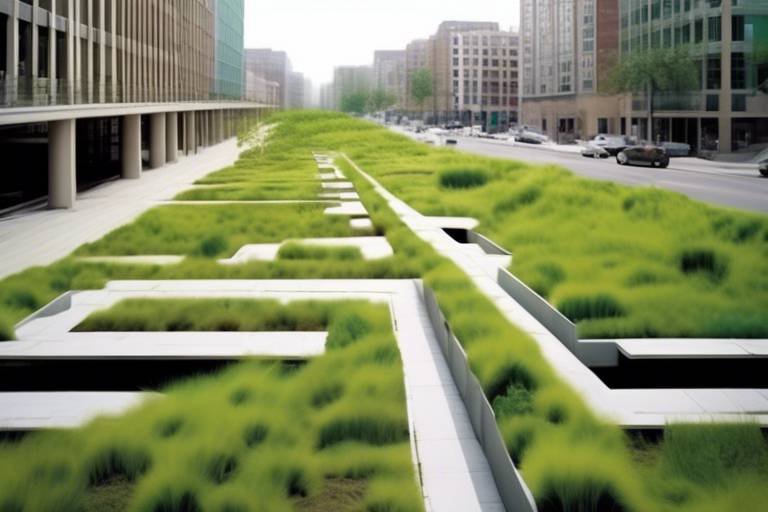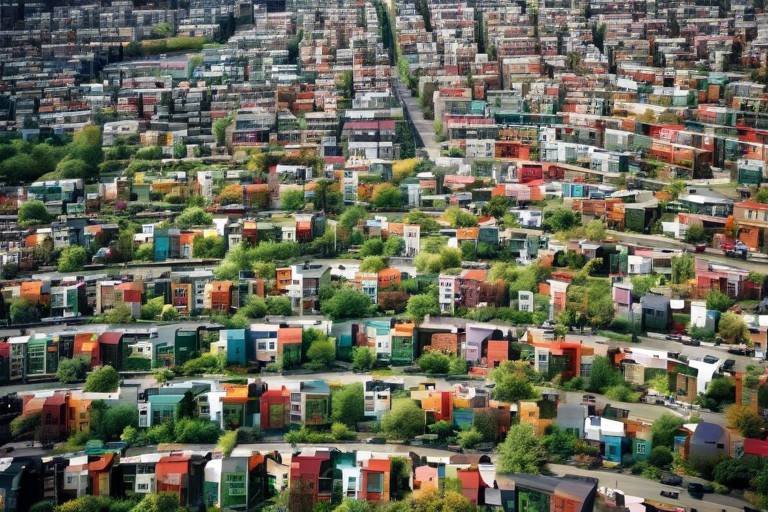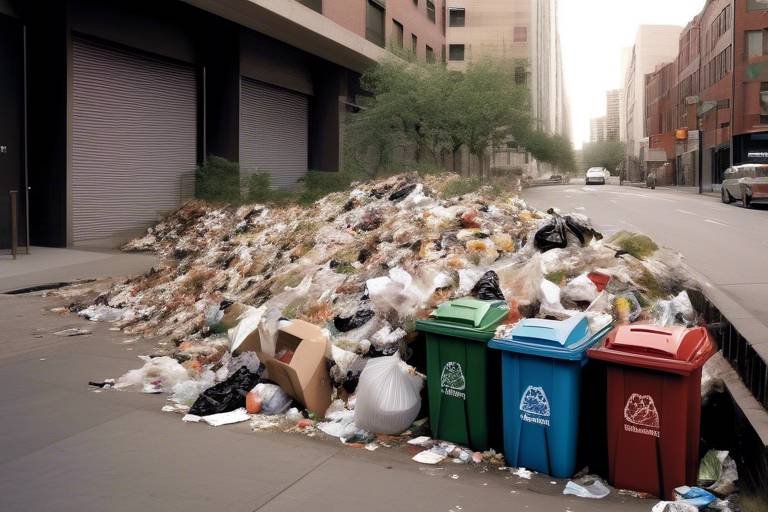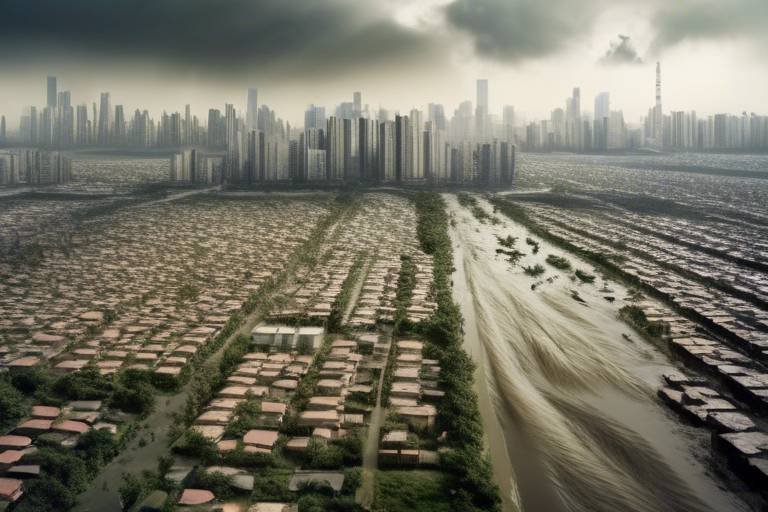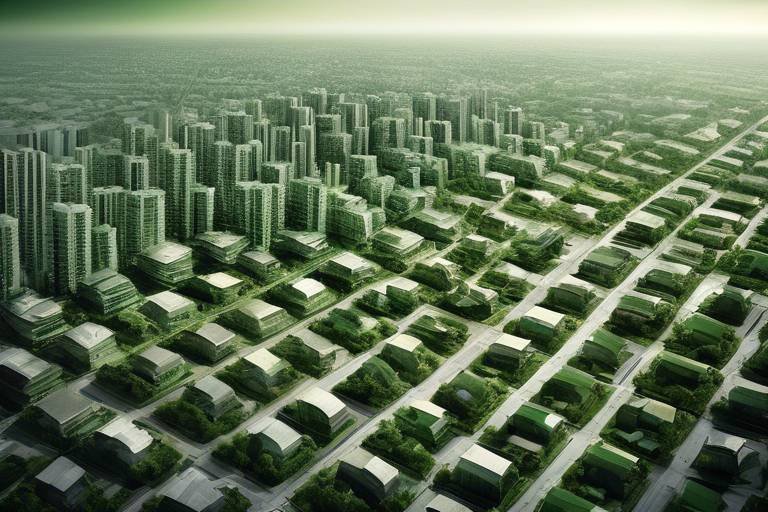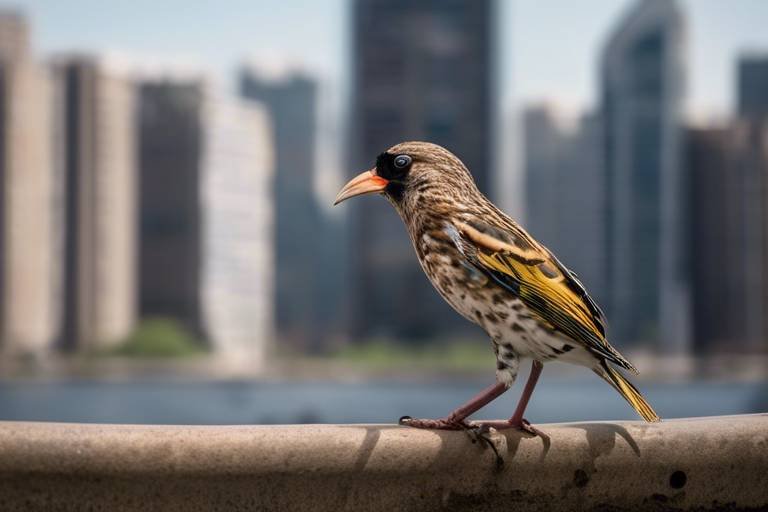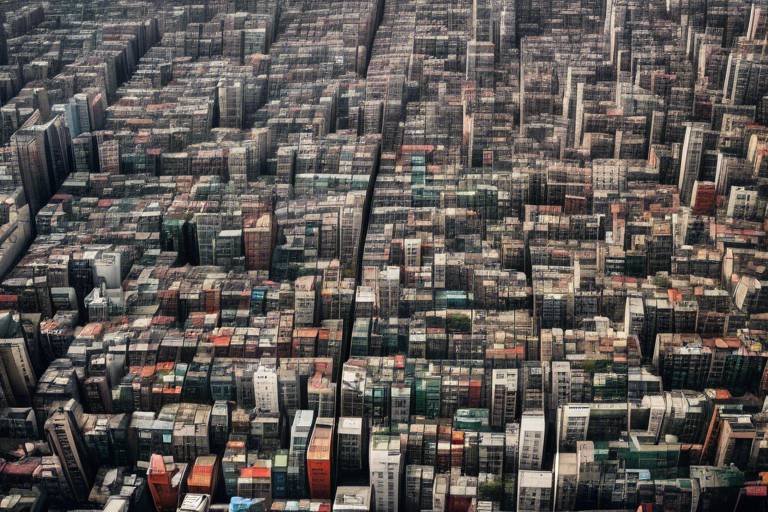How Green Infrastructure Shapes Sustainable Urban Spaces
In today’s rapidly urbanizing world, the concept of green infrastructure is becoming increasingly vital. As cities expand and the population density grows, we find ourselves grappling with a myriad of challenges such as air pollution, urban heat islands, and loss of biodiversity. This is where green infrastructure steps in, acting like a superhero cape for our urban environments. But what exactly is green infrastructure, and how does it contribute to creating sustainable urban spaces?
Green infrastructure refers to a network of natural and semi-natural systems that provide essential environmental services. Think of it as the lungs of a city, filtering the air we breathe and providing shade on hot summer days. It includes elements like parks, green roofs, urban forests, and permeable pavements, all working together to enhance urban ecosystems. The beauty of green infrastructure lies in its multifaceted benefits, which not only improve the quality of life for residents but also contribute to the overall health of the planet.
Imagine walking through a bustling city, surrounded by towering skyscrapers and the sounds of traffic. Now, picture that same city transformed with lush greenery, vibrant parks, and trees lining the streets. This transformation is not just aesthetic; it significantly impacts our environment. Green infrastructure plays a crucial role in improving air quality by absorbing pollutants and releasing oxygen. It helps mitigate the urban heat island effect by providing shade and cooling surfaces, making cities more bearable during sweltering summers. Furthermore, these green spaces foster biodiversity by creating habitats for various species, from birds to insects, which are essential for a balanced ecosystem.
As we delve deeper into the various forms of green infrastructure, it becomes evident that each type has unique contributions to urban sustainability. For instance, green roofs not only beautify buildings but also provide insulation and manage stormwater effectively. Urban forests serve as natural air purifiers and offer recreational spaces for residents. Permeable pavements allow rainwater to infiltrate the ground, reducing runoff and replenishing groundwater. Each element, while distinct, is interconnected, creating a robust framework for sustainable urban living.
Understanding why green infrastructure is vital for urban environments involves recognizing its role in improving air quality, reducing heat, and enhancing biodiversity. With the increasing concerns about climate change and environmental degradation, cities are turning to green infrastructure as a viable solution for many urban challenges. By integrating nature into urban planning, we can create spaces that are not only functional but also resilient and adaptable to future changes.
Exploring the various forms of green infrastructure reveals the depth of its impact on urban ecosystems. Here’s a closer look at some of the most significant types:
Green roofs are a fascinating example of how we can utilize our building spaces effectively. They consist of vegetation planted on rooftops, which can significantly reduce energy costs by providing natural insulation. Moreover, they are champions of stormwater management, absorbing rainwater and reducing runoff. As cities continue to grow vertically, the popularity of green roofs is on the rise, transforming barren rooftops into lush gardens.
The advantages of green roofs extend beyond aesthetics. Here are some key benefits:
- Environmental: They improve air quality and reduce urban heat.
- Economic: Green roofs can lower energy costs and increase property values.
- Social: They provide recreational spaces and enhance mental well-being.
However, the journey to widespread adoption of green roofs is not without its hurdles. Some challenges include:
- Cost: Initial installation can be expensive.
- Maintenance: Ongoing upkeep is necessary to ensure health and functionality.
- Structural Considerations: Not all buildings can support the additional weight of a green roof.
Urban forests are another critical component of green infrastructure. They provide essential shade, improve air quality, and serve as habitats for wildlife. In densely populated areas, these forests act as green lungs, helping to combat pollution and provide a natural escape for city dwellers.
Community engagement is paramount in the success of green infrastructure initiatives. When residents take ownership of their urban environment, they are more likely to participate in maintaining and enhancing these green spaces. This sense of responsibility fosters a deeper connection between people and their environment, creating a thriving urban ecosystem.
Several cities around the world have successfully integrated green infrastructure, showcasing innovative projects that have positively impacted urban sustainability. For instance, New York City’s MillionTreesNYC initiative aimed to plant one million trees, significantly improving urban air quality and providing essential green spaces for residents.
Looking ahead, emerging trends and technologies in green infrastructure are set to transform urban landscapes. Concepts like smart cities, which leverage technology to enhance urban living, are gaining traction. These developments promise to create more sustainable, efficient, and livable cities for future generations.
- What is green infrastructure? Green infrastructure refers to a network of natural and semi-natural systems that provide environmental benefits in urban settings.
- How does green infrastructure improve air quality? It absorbs pollutants and releases oxygen, contributing to cleaner air in urban environments.
- What are the challenges of implementing green roofs? Cost, maintenance, and structural considerations are significant challenges to widespread adoption.
- Why is community involvement important? Community engagement fosters ownership and responsibility, ensuring the sustainability of green projects.

The Importance of Green Infrastructure
In today's rapidly urbanizing world, the concept of green infrastructure has emerged as a beacon of hope for creating sustainable urban environments. But what exactly does this mean? Simply put, green infrastructure refers to a network of natural and semi-natural systems that provide essential services to urban areas. These systems play a crucial role in enhancing the quality of life for city dwellers by addressing some of the most pressing environmental challenges we face today.
One of the primary benefits of green infrastructure is its ability to improve air quality. Urban areas are notorious for their high levels of pollution, which can lead to serious health issues. By incorporating green spaces like parks, gardens, and trees, cities can significantly reduce airborne pollutants. Trees, for example, act as natural air filters, absorbing harmful gases and releasing oxygen. This not only makes the air cleaner but also creates a more pleasant atmosphere for residents.
Moreover, green infrastructure helps to mitigate the urban heat island effect, where city temperatures can be significantly higher than surrounding rural areas. This phenomenon occurs due to the extensive use of concrete and asphalt, which absorb and retain heat. By integrating green roofs, urban forests, and green walls, cities can lower surface and air temperatures, making them more comfortable during sweltering summer months. Imagine walking through a city where shady trees line your path, providing a cool respite from the heat—sounds inviting, right?
Another vital aspect of green infrastructure is its contribution to biodiversity. Urban areas are often seen as concrete jungles, devoid of wildlife. However, by creating green corridors and habitats, cities can support various species, from birds to pollinators. This not only enriches the urban ecosystem but also fosters a connection between residents and nature. Think of it as creating a vibrant tapestry of life amidst the hustle and bustle of city living.
Additionally, green infrastructure plays a significant role in stormwater management. Traditional urban drainage systems can be overwhelmed during heavy rains, leading to flooding and water pollution. Green infrastructure solutions, such as permeable pavements and bioswales, allow rainwater to infiltrate the ground, reducing runoff and filtering pollutants. This not only protects local waterways but also helps recharge groundwater supplies. It's a win-win situation for both the environment and urban residents.
In summary, the importance of green infrastructure in urban environments cannot be overstated. It enhances air quality, combats heat, supports biodiversity, and improves stormwater management. As cities continue to grow, embracing these natural solutions will be essential for creating livable, sustainable urban spaces. So, the next time you see a green roof or a community garden, remember that these are not just pretty sights—they are vital components of our urban ecosystems!

Types of Green Infrastructure
When we think about green infrastructure, it’s like opening a treasure chest filled with innovative solutions that breathe life into our urban environments. The beauty of green infrastructure lies in its versatility and its ability to tackle multiple urban challenges simultaneously. From green roofs to urban forests and permeable pavements, each type plays a crucial role in enhancing the sustainability of our cities. Let's dive into these different forms and see how they contribute uniquely to urban ecosystems.
Green roofs are perhaps the most iconic representation of green infrastructure. Imagine a lush garden sitting atop a skyscraper, providing not just aesthetic appeal but also functional benefits. These roofs are designed to support vegetation, which can absorb rainwater, provide insulation, and even reduce the urban heat island effect. By covering rooftops with greenery, cities can significantly lower energy costs while also improving air quality. It’s like giving a building a refreshing breath of fresh air!
Then we have urban forests, which are essentially patches of trees and shrubs integrated into city landscapes. These green sanctuaries act as the lungs of urban areas, filtering pollutants and producing oxygen. They provide vital shade during hot summer months, making our streets more bearable. Moreover, urban forests create habitats for wildlife, promoting biodiversity right in the heart of the city. It’s a win-win situation where both humans and nature thrive together.
Another fascinating element of green infrastructure is permeable pavements. Unlike traditional concrete or asphalt, permeable pavements allow water to seep through, reducing runoff and minimizing the risk of flooding. Think of it as a sponge that absorbs rainwater, replenishing groundwater supplies instead of overwhelming drainage systems. This innovative solution not only helps manage stormwater but also contributes to the overall health of urban ecosystems.
In addition to these, there are other forms of green infrastructure worth mentioning, such as bioswales, green walls, and community gardens. Bioswales are landscape elements designed to concentrate or remove debris and pollution from surface runoff water. Green walls, or vertical gardens, can transform bland building facades into vibrant living walls that improve air quality and reduce noise pollution. Community gardens, on the other hand, empower residents to cultivate their own food while fostering a sense of community and connection to nature.
Overall, the types of green infrastructure available today are diverse and adaptable. Each type serves a unique purpose, yet they all share a common goal: to create healthier, more sustainable urban spaces. By integrating these green solutions into our city planning, we can pave the way for a brighter, greener future.
- What is green infrastructure? Green infrastructure refers to a network of natural and semi-natural systems that provide environmental, economic, and social benefits in urban areas.
- How do green roofs help the environment? Green roofs improve air quality, reduce energy consumption, manage stormwater, and enhance urban biodiversity.
- What are urban forests? Urban forests are collections of trees and vegetation found in cities that contribute to air quality improvement, shade provision, and wildlife habitats.
- Can permeable pavements really help with flooding? Yes! Permeable pavements allow rainwater to soak through, reducing surface runoff and the risk of flooding.

Green Roofs
Green roofs are not just a trend; they are a revolutionary approach to urban living that combines functionality with sustainability. Imagine walking through a bustling city, surrounded by towering buildings, and suddenly spotting a vibrant green oasis atop a structure. This is the magic of green roofs, which transform ordinary rooftops into lush gardens that provide a multitude of benefits. These living roofs are designed to support vegetation, offering a unique solution to some of the pressing challenges faced by urban environments today.
One of the most significant advantages of green roofs is their ability to improve insulation. By adding a layer of soil and plants, these roofs can significantly reduce heating and cooling costs. In the summer, the plants absorb sunlight, keeping buildings cooler, while in the winter, the insulation helps retain heat. This not only leads to a reduction in energy bills but also contributes to a decrease in the urban heat island effect, where city areas become significantly warmer than their rural surroundings due to human activities.
Moreover, green roofs play a crucial role in stormwater management. Urban areas often struggle with excessive runoff during rainstorms, leading to flooding and pollution. Green roofs absorb rainwater, allowing it to evaporate slowly or be used by plants, thus reducing the volume of water that flows into drainage systems. This process can mitigate the risk of flooding and decrease the burden on municipal stormwater systems.
In addition to their environmental benefits, green roofs also enhance urban biodiversity. They provide a habitat for various species, including birds, insects, and other wildlife, which are often displaced by urban development. By creating these green spaces, cities can foster a more balanced ecosystem. For instance, the presence of pollinators such as bees and butterflies can be encouraged through the careful selection of plants on green roofs, contributing to the overall health of urban flora.
While the benefits are clear, the implementation of green roofs does come with its own set of challenges. The initial cost can be a significant barrier for many developers and homeowners. Installing a green roof involves not only the expense of the plants and soil but also structural considerations to ensure that the building can support the additional weight. Furthermore, ongoing maintenance is essential to keep these green spaces thriving. Regular watering, weeding, and plant replacement are necessary to maintain their health and aesthetics.
Despite these challenges, the popularity of green roofs is on the rise. Cities around the world are recognizing their value and are increasingly incorporating them into urban planning. For example, cities like Toronto and Chicago have implemented policies and incentives to encourage green roof installations. As more success stories emerge, the trend is likely to continue, paving the way for greener, more sustainable urban environments.
In summary, green roofs represent a powerful tool in the quest for sustainable urban living. They not only enhance the aesthetic appeal of cities but also provide essential environmental benefits. As we look towards the future, embracing the concept of green roofs could be a game-changer for urban spaces, making our cities not just places to live but thriving ecosystems.
- What is a green roof? A green roof is a roof that is partially or completely covered with vegetation, soil, and a growing medium, which can also include drainage and irrigation systems.
- How do green roofs help with energy efficiency? Green roofs provide insulation, reducing the need for heating in the winter and cooling in the summer, which leads to lower energy bills.
- Are green roofs expensive to install? Yes, the initial installation cost can be high, but they can lead to long-term savings through reduced energy costs and improved property values.
- What types of plants are suitable for green roofs? Drought-resistant plants and native species are often preferred for their low maintenance and ability to thrive in the rooftop environment.

Benefits of Green Roofs
Green roofs are not just a pretty face on top of buildings; they bring a plethora of environmental, economic, and social benefits that can transform urban landscapes. Imagine a bustling city where the air is cleaner, the temperature is cooler, and the overall quality of life is enhanced. That’s the magic of green roofs!
One of the most significant environmental advantages of green roofs is their ability to improve air quality. By absorbing carbon dioxide and releasing oxygen, these lush spaces act as natural air purifiers. Additionally, they filter pollutants and dust from the air, creating a healthier atmosphere for city dwellers. Think of them as nature’s own air conditioning units, working tirelessly to keep the air fresh and breathable.
Moreover, green roofs play a crucial role in stormwater management. They absorb rainwater, reducing runoff and minimizing the risk of urban flooding. This is particularly vital in cities where concrete jungles dominate the landscape, and natural drainage systems are overwhelmed. By retaining water, green roofs also help to cool the surrounding environment, mitigating the urban heat island effect, which can raise city temperatures significantly.
Let’s not forget about the economic benefits! Installing a green roof can lead to substantial energy savings. During the summer months, the insulation provided by the vegetation helps keep buildings cooler, reducing the need for air conditioning. In winter, the same insulation helps retain heat, leading to lower heating costs. Over time, these savings can add up to a considerable amount, making green roofs a wise investment for property owners.
Furthermore, properties with green roofs often see an increase in property values. Buyers are increasingly attracted to homes and commercial spaces that feature green roofs, viewing them as modern and eco-friendly. This trend not only benefits individual property owners but also enhances the overall aesthetic appeal of neighborhoods, making them more desirable places to live and work.
On a social level, green roofs can foster a sense of community. They can serve as communal spaces where residents gather, relax, and enjoy nature amidst the urban chaos. This connection to nature has been shown to improve mental health, reduce stress, and encourage a more active lifestyle. Imagine stepping out onto a lush green terrace instead of a concrete rooftop; it’s like finding a hidden oasis in the middle of a bustling city!
In conclusion, the benefits of green roofs are far-reaching and multifaceted. They not only contribute to environmental sustainability but also provide economic advantages and enhance social well-being. As cities continue to grow and evolve, integrating green roofs into urban planning is not just a trend; it’s a necessity for creating healthier, more sustainable urban environments.
- What are green roofs made of? Green roofs typically consist of a waterproof membrane, a drainage layer, a growing medium, and various types of vegetation.
- How much maintenance do green roofs require? While they do require some maintenance, such as weeding and irrigation, they are generally low-maintenance compared to traditional gardens.
- Can any building support a green roof? Not all buildings are suitable for green roofs. Structural assessments are necessary to determine if a building can support the additional weight.
- Are there any financial incentives for installing green roofs? Many cities offer tax credits, grants, or subsidies for green roof installations as part of their sustainability initiatives.

Challenges of Implementing Green Roofs
While the benefits of green roofs are numerous and compelling, their implementation is not without challenges. One of the primary hurdles is the initial cost associated with installation. Unlike traditional roofing systems, green roofs require a significant upfront investment in materials and labor. This can deter property owners and developers who may be hesitant to spend more money initially, despite the long-term savings that green roofs can provide.
Another challenge is the maintenance required to keep these living systems healthy and functional. Green roofs need regular upkeep, including irrigation, weeding, and periodic inspections to ensure that plants are thriving and that the roof remains structurally sound. This ongoing maintenance can be daunting for some property owners, particularly those who may not have the resources or knowledge to manage a green space effectively.
Moreover, structural considerations play a crucial role in the feasibility of green roofs. Not every building is equipped to handle the additional weight of soil, plants, and water. Before installation, a thorough evaluation by structural engineers is necessary to determine if a building can support a green roof without compromising its integrity. This adds another layer of complexity to the planning process.
There are also regulatory challenges that can impede the widespread adoption of green roofs. Different cities have varying building codes and zoning laws, which can restrict the ability to install green roofs. Navigating these regulations can be time-consuming and may require additional permits or approvals, further complicating the process.
Lastly, there is often a lack of awareness and understanding among the general public and even some professionals about the benefits and maintenance of green roofs. This knowledge gap can lead to skepticism about their effectiveness, making it harder to gain support for such initiatives. Education and outreach are essential to overcoming these barriers and fostering a culture that embraces green infrastructure.
In summary, while green roofs offer a plethora of environmental and economic benefits, their implementation is fraught with challenges that need to be addressed. From financial constraints to structural limitations and regulatory hurdles, stakeholders must work collaboratively to find solutions that will enable the successful integration of green roofs into urban landscapes.
- What are green roofs? Green roofs are living roofs that are partially or completely covered with vegetation, soil, and a growing medium, which can provide various environmental benefits.
- How much do green roofs cost? The cost of green roofs can vary widely based on design, size, and materials used, but they typically require a higher initial investment compared to traditional roofs.
- What maintenance do green roofs require? Green roofs require regular maintenance, including watering, weeding, and inspections to ensure the health of the plants and the structural integrity of the roof.
- Can any building support a green roof? Not all buildings are suitable for green roofs; a structural assessment is necessary to determine if a building can support the additional weight.
- What are the environmental benefits of green roofs? Green roofs improve air quality, reduce urban heat, manage stormwater, and enhance biodiversity, making them valuable assets in urban areas.

Urban Forests
Urban forests are often the unsung heroes of city landscapes, providing a plethora of benefits that extend far beyond just aesthetics. Imagine walking through a bustling city, surrounded by towering buildings and the constant hum of traffic, only to find a serene patch of greenery where birds chirp, and sunlight filters through the leaves. This is the magic of urban forests. They play a crucial role in enhancing the quality of life in urban areas by offering shade, improving air quality, and supporting diverse wildlife habitats.
The presence of urban forests can significantly mitigate the urban heat island effect, where cities become significantly warmer than their rural surroundings due to human activities and infrastructure. Trees act as natural air conditioners, cooling the environment through shade and evapotranspiration. This cooling effect not only makes outdoor spaces more enjoyable but also reduces the need for air conditioning in nearby buildings, leading to lower energy consumption and costs.
Furthermore, urban forests are vital for improving air quality. They absorb pollutants such as carbon dioxide, sulfur dioxide, and nitrogen oxides, while also filtering particulates out of the air. A single mature tree can absorb around 48 pounds of carbon dioxide per year, making them powerful allies in the fight against climate change. Additionally, trees release oxygen, contributing to healthier urban atmospheres. The sheer importance of these green spaces cannot be overstated, as they are essential for the health and well-being of city dwellers.
Another fascinating aspect of urban forests is their ability to support biodiversity. In densely populated areas, these green spaces serve as critical habitats for various species of birds, insects, and other wildlife. By creating a network of green corridors, urban forests enable species to thrive and move freely, contributing to ecological balance within the city. They also enhance the aesthetic value of neighborhoods, making them more appealing to residents and visitors alike.
However, managing urban forests comes with its own set of challenges. Urban planners and city officials must navigate issues such as land use conflicts, maintenance costs, and the need for public awareness and engagement. It's essential to foster a sense of community ownership over these green spaces. For instance, involving local residents in tree planting initiatives not only enhances the forest but also strengthens communal bonds. When people feel connected to their urban forests, they are more likely to advocate for their preservation and care.
To illustrate the impact of urban forests, consider the following table that highlights some key benefits:
| Benefit | Description |
|---|---|
| Air Quality Improvement | Trees filter pollutants and produce oxygen, enhancing the overall air quality. |
| Temperature Regulation | Urban forests help lower temperatures, reducing energy costs for cooling. |
| Biodiversity Support | Provide habitats for various species, promoting ecological diversity. |
| Community Well-being | Enhance mental health and encourage outdoor activities among residents. |
In conclusion, urban forests are more than just a collection of trees; they are vital ecosystems that contribute to the sustainability and livability of urban areas. As cities continue to grow and evolve, integrating urban forests into city planning will be essential for creating resilient and vibrant communities. By recognizing their value and advocating for their preservation, we can ensure that future generations enjoy the myriad benefits that urban forests provide.
- What is an urban forest? An urban forest is a collection of trees and vegetation located within a city or town that provides ecological, social, and economic benefits.
- How do urban forests improve air quality? Urban forests absorb air pollutants and release oxygen, significantly improving the air quality in urban areas.
- Can urban forests help combat climate change? Yes, by sequestering carbon dioxide and reducing energy consumption, urban forests play a crucial role in mitigating climate change impacts.
- What can communities do to support urban forests? Communities can participate in tree planting initiatives, advocate for green space preservation, and engage in educational programs about the importance of trees.

Community Involvement in Green Projects
When it comes to transforming urban landscapes into greener, more sustainable spaces, community involvement is the secret ingredient that can make all the difference. Imagine a neighborhood where residents not only witness changes but actively participate in them; this is the essence of community engagement in green projects. It’s like a symphony where everyone plays a vital role, contributing their unique notes to create a harmonious environment. But why is this involvement so crucial?
First off, community engagement fosters a sense of ownership and responsibility. When local residents take part in planning and implementing green initiatives, they develop a personal connection to the project. This connection can lead to better care and maintenance of green spaces, ensuring that these projects thrive long after their completion. Think of it as planting a seed in the hearts of the community; when nurtured, it grows into a flourishing tree of sustainability.
Moreover, involving the community in green projects can lead to more tailored solutions. Residents have firsthand knowledge of their environment and can provide insights that professionals might overlook. For instance, a local park redesign might incorporate features that reflect the community's culture or address specific needs, such as playgrounds for children or quiet spaces for relaxation. This kind of input can significantly enhance the effectiveness and acceptance of green initiatives.
However, engaging the community isn't just about gathering opinions; it’s about creating a vibrant dialogue. Workshops, public meetings, and interactive platforms can facilitate discussions where residents can voice their ideas and concerns. This two-way communication builds trust and transparency, making the community feel valued and heard. When people feel their voices matter, they are more likely to participate actively in the project’s success.
One effective approach to foster community involvement is through volunteer programs. These initiatives can bring together diverse groups of people, from students to retirees, all united by a common goal: to beautify and enhance their surroundings. For example, organizing tree-planting days or community clean-up events not only improves the local environment but also strengthens social bonds among residents. It’s a win-win situation!
To illustrate the impact of community involvement, let’s look at a few successful projects:
| City | Project | Community Role | Outcome |
|---|---|---|---|
| Philadelphia | Green City, Clean Waters | Local workshops and volunteer days | Improved water quality and increased green space |
| Melbourne | Urban Forest Strategy | Community tree planting and monitoring | Enhanced biodiversity and reduced urban heat |
| Toronto | Community Gardens | Residents design and maintain gardens | Increased local food production and community engagement |
In conclusion, community involvement in green projects is not just beneficial; it’s essential. It cultivates a sense of belonging, ensures projects meet local needs, and creates lasting relationships among residents. As cities continue to evolve, fostering this spirit of collaboration will be key to building sustainable urban environments that reflect the values and aspirations of their inhabitants.
Q: How can I get involved in local green projects?
A: Check with your local government or community organizations to find volunteer opportunities or public meetings related to green initiatives.
Q: What are some examples of community-led green projects?
A: Community gardens, tree planting events, and local clean-up days are great examples of projects led by residents.
Q: Why is community engagement important for sustainability?
A: Engaging the community ensures that projects are relevant, well-maintained, and supported by those who live in the area, leading to more successful outcomes.

Case Studies of Successful Initiatives
When it comes to green infrastructure, real-world examples can be incredibly inspiring. They not only showcase the potential benefits but also provide a roadmap for other cities looking to enhance their sustainability efforts. Let’s dive into some remarkable case studies that illustrate how urban areas have successfully integrated green infrastructure into their landscapes.
First up, we have Singapore, often hailed as a “City in a Garden.” This vibrant city-state has taken significant strides in incorporating greenery into its urban fabric. One of its flagship projects is the Gardens by the Bay, which features stunning supertrees that act as vertical gardens. These structures not only provide aesthetic beauty but also contribute to biodiversity, serve as air filters, and even generate solar energy. The success of this project has inspired other cities around the world to rethink their approach to urban planning.
Next, let’s look at New York City, which has embraced the idea of green roofs with open arms. The Brooklyn Grange is a prime example, boasting the largest rooftop soil farm in the world. This initiative has transformed unused rooftop space into productive gardens, providing fresh produce to local communities and reducing the urban heat island effect. Moreover, green roofs in NYC have been shown to help with stormwater management, absorbing rainwater and reducing runoff. The city’s CoolRoofs program further complements this by encouraging reflective roofing materials to lower building temperatures.
Another noteworthy case is Portland, Oregon, which has been a pioneer in promoting urban forests. The city launched the Urban Forestry Management Plan, aiming to increase tree canopy cover and improve air quality. This initiative has not only enhanced the aesthetic appeal of neighborhoods but also provided shade, reduced energy costs for cooling, and improved overall public health. Portland’s commitment to maintaining and expanding its urban forest has made it a model for cities aiming to tackle climate change through greenery.
Moreover, Toronto has implemented a comprehensive Green Streets program that integrates various green infrastructure elements into its roadways. This includes permeable pavements, bioswales, and tree plantings that work together to manage stormwater effectively. By reducing flooding and improving water quality, Toronto is setting a benchmark for urban resilience. The city’s approach demonstrates how integrating nature into transportation infrastructure can yield multiple benefits.
To summarize, these case studies highlight the transformative power of green infrastructure in urban settings. Each city has tailored its initiatives to its unique challenges and opportunities, proving that with creativity and commitment, we can build more sustainable urban environments. As cities continue to grapple with issues like climate change and urbanization, these examples serve as a beacon of hope and a call to action.
- What is green infrastructure?
Green infrastructure refers to a network of natural and semi-natural systems that provide environmental benefits in urban areas, such as parks, green roofs, and permeable surfaces. - How does green infrastructure benefit cities?
It improves air quality, reduces urban heat, manages stormwater, enhances biodiversity, and promotes community well-being. - Can green infrastructure be affordable?
While initial costs can be higher, long-term savings on energy, water management, and health can make green infrastructure a cost-effective solution. - What are some challenges in implementing green infrastructure?
Challenges may include funding, maintenance, space constraints, and the need for community buy-in.

Future Trends in Green Infrastructure
As we gaze into the crystal ball of urban development, it's clear that green infrastructure is not just a fleeting trend but a fundamental shift in how we conceive our cities. Imagine walking through a bustling metropolis, where nature coexists harmoniously with urban life. This vision is becoming a reality, driven by innovative technologies and a growing awareness of sustainability. So, what are the future trends that will shape this green revolution?
First and foremost, the rise of smart cities is paving the way for greener infrastructure. These cities leverage technology to enhance the efficiency of urban systems, integrating real-time data to manage resources better. For instance, sensors can monitor air quality and adjust green spaces accordingly to improve public health. This tech-savvy approach allows for a more responsive and adaptive urban environment, ensuring that green spaces are not just an afterthought but a vital component of city planning.
Moreover, the concept of biophilic design is gaining traction. This design philosophy emphasizes the connection between humans and nature, promoting environments that foster well-being. Architects and urban planners are increasingly incorporating natural elements into their designs—think of buildings adorned with living walls or parks that mimic natural ecosystems. By bridging the gap between the urban and the natural world, biophilic design enhances mental health, reduces stress, and creates a more enjoyable urban experience.
Another exciting trend is the implementation of green corridors. These are dedicated pathways that connect various green spaces throughout a city, allowing for seamless movement of both people and wildlife. Imagine a network of parks, gardens, and greenways that not only beautifies the landscape but also supports biodiversity. These corridors can serve as vital habitats for urban wildlife, promoting ecological health while providing residents with recreational opportunities. The integration of green corridors into urban planning signifies a shift towards a more interconnected and sustainable urban ecosystem.
Furthermore, we can expect to see an increase in community-driven initiatives that empower residents to take charge of their local environments. As people recognize the importance of green spaces, grassroots movements are emerging to advocate for and implement green projects. This could involve transforming vacant lots into community gardens or organizing tree-planting events. When communities come together, they not only enhance their surroundings but also foster a sense of belonging and ownership, which is crucial for the long-term success of green infrastructure.
Lastly, the future will likely see advancements in sustainable materials used for green infrastructure. Innovations in eco-friendly building materials—such as recycled plastics, bamboo, and other renewable resources—are making it easier to create sustainable urban spaces. These materials not only reduce the carbon footprint of construction but also enhance the durability and functionality of green installations. As technology continues to evolve, we can anticipate even more groundbreaking materials that contribute to the sustainability of our cities.
In conclusion, the future of green infrastructure is not just about adding a few plants here and there; it’s about reimagining our urban landscapes to create a more sustainable, livable, and connected environment. With smart technology, biophilic design, green corridors, community involvement, and innovative materials leading the charge, we are on the brink of a green revolution that promises to transform our cities for generations to come.
- What is green infrastructure? Green infrastructure refers to a network of natural and semi-natural features that provide environmental, social, and economic benefits in urban areas.
- How does green infrastructure improve air quality? Green infrastructure, such as trees and plants, helps filter pollutants from the air, thereby improving overall air quality.
- Can green roofs really save energy? Yes, green roofs provide insulation, reducing the need for heating in winter and cooling in summer, which can lead to significant energy savings.
- What role do communities play in green infrastructure? Community involvement is crucial for the success of green projects, as it fosters a sense of ownership and responsibility among residents.
Frequently Asked Questions
- What is green infrastructure?
Green infrastructure refers to a network of natural and semi-natural systems that provide environmental, social, and economic benefits in urban areas. It includes features like green roofs, urban forests, and permeable pavements that help manage stormwater, improve air quality, and enhance biodiversity.
- How does green infrastructure improve air quality?
Green infrastructure plays a crucial role in filtering pollutants from the air. Plants absorb carbon dioxide and release oxygen, while trees and vegetation can trap dust, smoke, and other harmful particles, resulting in cleaner, healthier air for city residents.
- What are the benefits of installing green roofs?
Green roofs offer numerous advantages, including improved insulation, reduced energy costs, and effective stormwater management. They also enhance urban aesthetics, increase property values, and provide habitats for various species, contributing to overall urban biodiversity.
- What challenges are associated with implementing green roofs?
While green roofs have many benefits, there are challenges to their adoption. These include high initial costs, ongoing maintenance requirements, and structural considerations for existing buildings. Overcoming these hurdles often requires careful planning and investment.
- Why are urban forests important?
Urban forests provide essential benefits such as shade, improved air quality, and wildlife habitats. They help mitigate urban heat island effects, making cities more livable and resilient against climate change. Additionally, they offer recreational spaces for residents.
- How can communities get involved in green infrastructure projects?
Community engagement is vital for the success of green infrastructure initiatives. Residents can participate by volunteering for tree planting events, joining local environmental organizations, or advocating for green projects in their neighborhoods, fostering a sense of ownership and responsibility.
- What are some successful examples of green infrastructure in cities?
Many cities have successfully integrated green infrastructure. For instance, New York City has implemented extensive green roof programs, while Singapore is renowned for its vertical gardens and urban parks. These initiatives have led to improved urban sustainability and enhanced quality of life for residents.
- What future trends can we expect in green infrastructure?
Future trends in green infrastructure include the integration of smart city technologies, such as sensors for monitoring environmental conditions and automated irrigation systems. These innovations will help optimize the benefits of green infrastructure and further enhance urban environments for future generations.

